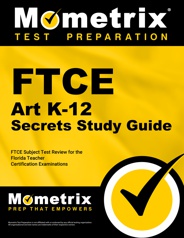The Florida Teacher Certification Examinations (FTCE) have been implemented as a part of the teacher certification process in the State of Florida. The FTCE Art K-12 exam is specific to teaching candidates who wish to enter the teaching field as art teachers in grade levels K-12.
The FTCE Art K-12 exam ensures teaching candidates meet the highest standards so as to ensure Florida students receive a highly effective, quality education.
The FTCE Art K-12 exam is only one part of the certification process for potential Florida teachers, so make sure to check with the Florida Department of Education website, as well as your teaching certification education program, to ensure you meet all credentialing requirements.
How much does the FTCE Art K-12 exam cost?
The FTCE Art K-12 exam will cost $150 for your first attempt and $150 for retakes. A retake might need to occur if you did not receive a high enough score on your initial attempt.
What is the passing score for the FTCE Art K-12 exam?
The passing score for the FTCE Art K-12 is scaled; you must score at least 200 to pass. Score reports will be available as pass/non-pass immediately after you finish the exam, and official score reports will be available within 4 weeks of your test date.
As aforementioned, if you need to retake the exam, you can do so; however, you will be assessed a $150 fee every time you have to retake the exam.
What does the FTCE Art K-12 exam cover?
The FTCE Art K-12 exam is a computer-based test (CBT) consisting of approximately 110 multiple-choice questions. While you will notice that your testing window is longer than the time provided for the exam, the total testing time allotted to answer questions on the exam is 2 hours and 30 minutes.
Taking breaks during the exam eats into your available testing time, so make sure to plan accordingly. You will take the exam at a Pearson VUE computer-based testing (CBT) site in your area.
In terms of exam content, the FTCE Art K-12 exam will cover several competencies and skills. Each competency area is weighted in terms of its percentage of total test questions. The competency areas, skills covered, and approximate weighted percentages are as follows:
- Knowledge of two-dimensional art processes, approximately 15%
- Demonstrate knowledge of materials, processes, tools, and characteristics of two-dimensional art, i.e., painting, drawing, printmaking; application of knowledge pertaining to media, safety procedures, and proper use of hazardous substances and equipment.
- Knowledge of three-dimensional art processes, approximately 15%
- Demonstrate knowledge of materials, processes, tools, and characteristics of three-dimensional art, i.e., ceramics, sculpture, mixed media; application of knowledge pertaining to media, safety procedures, and proper use of hazardous substances and equipment.
- Knowledge of digital arts processes, approximately 15%
- Demonstrate knowledge of materials, processes, tools, and characteristics of digital art, i.e., photography, graphic design; application of knowledge pertaining to media, safety procedures, and proper use of hazardous substances and equipment.
- Knowledge of art history and culture, approximately 15%
- Demonstrate knowledge of art movements, periods, styles, genres, major artists, and major works; analysis of the role of art in world cultures and throughout history.
- Knowledge of art criticism, approximately 15%
- Application of the critical process of analysis, description, evaluation, and interpretation of art; knowledge of aesthetic theories, principles, and inspiration.
- Knowledge of pedagogy and art education, approximately 15%
- Analysis of historical, social, and philosophical art education foundations; application of theories regarding child development, curriculum; application of ethics, equity, fairness, and appropriate methods of evaluation and assessment.
- Knowledge of present-day applications of art and connections, approximately 10%
- Analysis of interconnectedness between art and other disciplines; career opportunities in art; analysis of real-world art applications.
Test Preparation
By now, you should have a good understanding of the fees, content, and basic structure of the FTCE Art K-12 exam. What comes next? The best means of ensuring your success on the FTCE Art K-12 exam is to prepare using the most reliable test preparation materials available. Mometrix Test Preparation has everything you need in the FTCE Secrets study guide. The FTCE Secrets study guide includes real FTCE exam content and expert tips designed to help you remember information, reduce test anxiety, and pass the FTCE Art K-12 exam on your first attempt.
Along with the FTCE Secrets study guide, Mometrix Test Preparation also offers a comprehensive FTCE Practice Test and a complete set of FTCE Exam Flashcards. Read the FTCE Secrets study guide, evaluate your knowledge with the FTCE Flashcards and FTCE Practice Test, and take the right path toward passing the FTCE Art K-12 exam on your first attempt. The sooner you pass the FTCE, the sooner you begin teaching.





